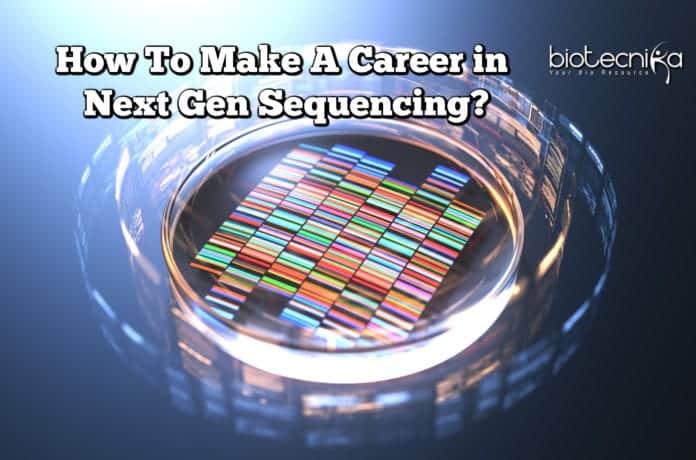How to Make a Career in Next Gen Sequencing – Job prospects
Current DNA sequencing methods cannot differentiate between the 2 states of genes i.e; when they are turned on or off. The next gen sequencing technologies can differentiate between the same. With the help of this technology, we can accurately identify cures for diseases !! There were certain misconceptions and drawbacks of Sanger sequencing methods that laid the foundation of these new and much more advanced sequencing technologies collectively termed as NEXT GENERATION SEQUENCING.
What is Sequencing?
You all are aware of the fact that our body is made up of DNA – A Hereditary material. DNA is made up of a nucleic acid sequence. In order to determine the nucleotides in DNA, sequencing was performed. Sequencing includes any method or technology that can be helpful in any way to determine and analyze the order of the four nucleotide bases: Adenine (A), Guanine (G), Cytosine (C) and Thymine (T). DNA sequencing is mostly performed by using the Chain Termination method of Frederick Sanger. This was the simplest technique that implies sequence-specific termination of a DNA synthesis reaction using modified nucleotide substrates.
Next Gen Sequencing Certification Course @ 93% Discount
Get NGS Certified
Nevertheless, certain new technologies of sequencing are acquiring a high share of the sequencing methods. Pyrosequencing is one of those that is generating more genome data than Sanger DNA sequencing method/technology.
What is NGS- Next Gen Sequencing?
Next-gen sequencing alludes to non-Sanger-based high-throughput DNA sequencing technologies. Many strands, almost Millions or billions of DNA strands can be sequenced in parallel, generating substantially more throughput and minimizing the need for the fragment-cloning methods that were used for Sanger sequencing of genomes. NGS has transfigured nearly most of the area of Biotechnology.
NGS allows the sequencing of nucleic acids like DNA and RNA much more quickly and in a cheaper manner than the older version of sequencing technologies. With the use of these technologies study of various branches of Biology such as Genetics and Molecular Biology are revolutionized. Next-gen sequencing includes different types of sequencing methods. Let’s have a look at these Sequencing methods and how they are far ahead from Sanger-based sequencing technology.
NGS utilizes vast numbers of short reads that are sequenced in a single stroke. To achieve this, the input sample is first chopped down into short sections. The various section lengths produced will depend on the fact that which particular sequencing methodology has been used.
Based on this NGS can be of three types described below:
Illumina (Solexa) Sequencing: This method works by simultaneously analyzing DNA bases as each base emits a unique fluorescent signal, and adding them to a nucleic acid chain. In this method: 100-150 bp reads are used. Longer fragments are ligated to generic adaptors which are then annealed to a slide with the help of adaptors. To amplify each read and to produce a spot with multiple copies of the same read, PCR is used. In the final step, multiple copies are split into single strands that are subjected to sequencing.
Roche 454 Sequencing: The second type of NGS is based on pyrosequencing that notices the release of pyrophosphate once nucleotides are subsumed by polymerase to a new DNA strand with the help of fluorescence. This method can sequence much longer reads than Illumina (up to 1kb), but the sequencing method remains the same. The read ends are attached to generic adaptors and are annealed to beads. Finally, PCR is used to amplify these fragments by adaptor- specific primers. Each well of a slide contains a single bead covered in multiple PCR copies of a single sequence in addition to Sequencing buffers and DNA polymerase.
Ion Torrent: Proton / PGM sequencing: This NGS method is unique in its own way. This sequencing method measures the direct release of H+ by the incorporation of individual bases / dNTP by DNA polymerase and thus shows the difference from the previous two methods as it does not measure optical signals. In this method, the read size is about 200bp. Adaptors are added and a molecule is deposited on a bead. With the help of emulsion PCR, molecules are amplified. Single well on a slide contains a single bead.
Applications of NGS :
Next-Generation Sequencing has an allied group of applications. With the advancement in various sequencing methods, the way to carry out various studies on molecular and genomic levels has been changed and modified. NGS has given us so much power to sequence and interprets genomes quickly and accurately. NGS is used to study various variations, DNA-binding as well as expression at a genome-wide level. With more advancement based on various research studies, one can get an idea of the immense potential of Next Gen Sequencing in numerous fields and the different tools that can be used for the analysis purpose.
Some of the Applications of NGS are listed below :
- Next generation sequencing techniques are applied to different aspects of Biological Sciences such as Plant Biotechnology, Animal Biotechnology, and Human Biotechnology.
- The plentiful information generated by NGS assists in analyzing genomic variations, various disease mechanisms, and its resistance.
- NGS has its applications in forensic genetics- NGS contributes to offering new possibilities for forensic genetic casework.
- This method of sequencing can be combined with various types of markers like STRs, SNPs, insertion/deletions, mRNA -to gather more information from unique samples in a single experiment.
- All these sorts of applications of Next generation sequencing help in development as well as the advancement of better diagnostic tools, breeds, and numerous therapies.
Career Options And Job Prospects:
You should always choose a field, which you are interested in. Always find out what you like doing best. Don’t go behind the crowd; Career choice should always be yours, What makes you happy -Choose that! If the details thus far given about NGS have enticed you then you probably must go for a career in this field.
NGS with its speed, ultra-high throughput, extensibility enables researchers to experiment and establish a variety of applications and also to study various biological systems at a level that was never possible before. NGS will remain as one of the most applied techniques for most of the research studies. So, it is always better to be a part of a bright and famed future. If you have a golden path in front you, why not have a walk on it!
If you are confused regarding your career options after your graduation or post-graduation, you can have this field as an option. I would rather say you should go for it as opportunity knocks only once.
Biotecnika launches Next Gen Sequencing Online Certification Course.
If you are an aspiring researcher, academician or a student, this is the golden opportunity to learn about this technology, glance at the research prospects in this avenue, and become aware of career opportunities in this field. Get the participation certificate (hard copy as well) and highlight your new skills on your resume.
Who must attend: Students in their B.Sc / B.Tech / M.Sc / M.Tech who aspire to work on cutting-edge research technologies of the FUTURE.
Enroll today @ learn NGS Self-Learning Course and be a part of the changing technology!
Where to apply for jobs after learning NGS Skills?
Today’s research world is all based on your knowledge and experience. After enrolling yourself in any one of the above-mentioned courses, you can easily apply your knowledge and skills of NGS in research. You can search for jobs in areas related to Personalized medicine, Preventive medicine, Gene Therapy, and Drug Development. You will be enriched with various skills after completing training courses in NGS- Literature mining, Sequence Alignment, Phylogenetics, Gene prediction.
Job Prospects: You can work as Field Applications Scientist, Scientist II, Associate Scientist, Sr Scientific Researcher, Program Manager, Microarray and NGS Curator. There are various openings for talented candidates in Commercial, R&D, Corporate, Software and Operations sections of highly reputed industries and institutes. You can also choose a career in research where you can join for a Ph.D. program in NGS.
Companies & Institutes Carrying out NGS Research :
- National Centre for Biological Sciences (NCBS)
- Illumina.
- Thermo Fisher Scientific.
- Roche.
- Qiagen.
- Agilent Technologies
- Macrogen
- Medgenome
- Mapmygenome
- Xcelris
- SciGenom
- BGI Genomics
 medalist & has been honored by former President of India Pranab Mukherjee in 2013. She is currently associated with Biotecnika as an Academic Support Specialist. She has published 3 Research Articles, 5 Research Papers and 1 Book Chapter in various National & International scientific journals. She is very passionate about teaching and loves to guide and inspire her students. She is very optimistic, organized, active and enjoys working with a wide variety of people to achieve a common goal efficiently and realistically.
medalist & has been honored by former President of India Pranab Mukherjee in 2013. She is currently associated with Biotecnika as an Academic Support Specialist. She has published 3 Research Articles, 5 Research Papers and 1 Book Chapter in various National & International scientific journals. She is very passionate about teaching and loves to guide and inspire her students. She is very optimistic, organized, active and enjoys working with a wide variety of people to achieve a common goal efficiently and realistically. 





































